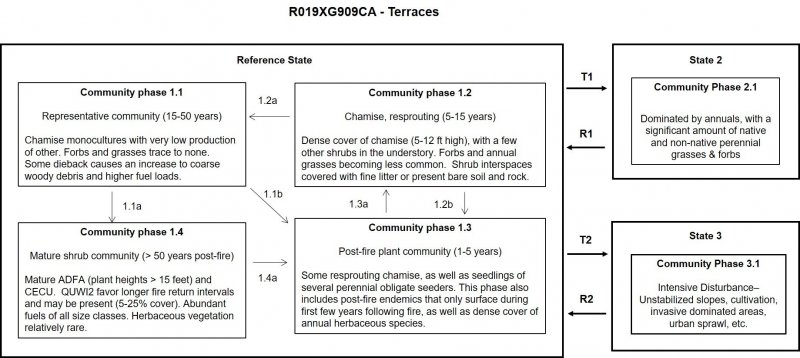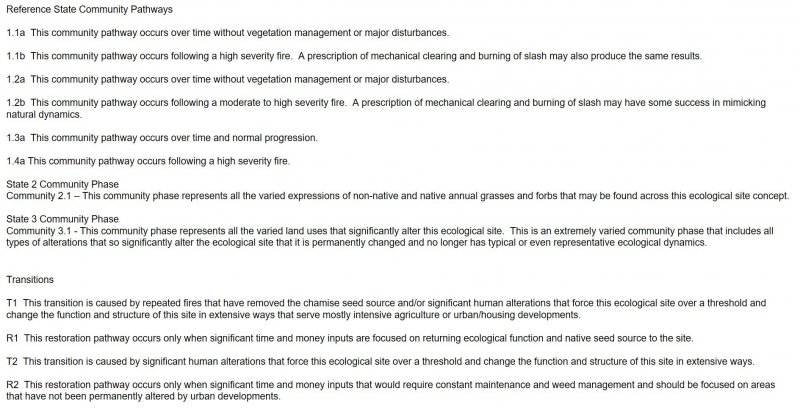Ecological site group R019XG909CA
Terrace
Last updated: 07/06/2023
Accessed: 12/21/2025
Ecological site group description
Key Characteristics
- located on terraces
Provisional. A provisional ecological site description has undergone quality control and quality assurance review. It contains a working state and transition model and enough information to identify the ecological site.
Physiography
This ESG is found commonly on terraces, escarpments, inset fans, washes, and old alluvial fans. Elevations range from sea level to 3000 feet, with slopes that vary depending on the landforms.
Climate
The average annual precipitation of this MLRA covers a diverse landscape of valleys and mountains and can range anywhere from 8 to 53 inches (215 to 1,354 millimeters), increasing with elevation. Most of the rainfall occurs as low- or moderate-intensity, Pacific frontal storms during winter. Rain can turn to snow at the higher elevations. A little snow may fall in winter, but it does not last. Summers are dry, but fog provides some moisture along the coast. The average annual temperature is 38 to 67 degrees F (3 to 19 degrees C). The freeze-free period averages 310 days in the valleys, 245 days in the mountains, and ranges from 125 to 365 days along the coast. It decreases in length with elevation. The longest freeze-free period occurs at the lower elevations along the western edge of the area.
Soil features
This ESG is found on varied soils that are typically Alfisols or Mollisols with varying soil textures and depths.
Some soils representative of this concept include Huerhuero, Rincon, Chualar, and Ramona.
Vegetation dynamics
Chamise chaparral may consist of nearly pure stands of chamise, a mixture of both, or with other shrubs. The purest stands of chamise occur on xeric, south-facing slopes. Toyon, sugar sumac, poison oak, redberry, and California buckthorn are commonly found in drainage channels and on other relatively mesic sites. At upper elevations or on more mesic exposures, chamise mixes with ceanothus, manzanita, scrub oak, and laurel sumac. In southern California, white sage, black sage, and California buckwheat are common at lower elevations and on recently disturbed sites.
Fire is the primary disturbance initiating secondary succession in chamise chaparral. Annuals, perennial herbs, and subshrubs are abundant for several years after a fire. Shrubs begin to appear either as seedlings or rootcrown sprouts beginning the first growing season after burning. As the habitat matures, shrub cover and height increase and herbaceous cover declines. Relatively short-lived shrubs and subshrubs, such as California buckwheat, common deerweed, and most species of ceanothus, may be absent or rare in older stands. After each fire, populations of these species and post-fire herbs regenerate quickly from the seed bank in the soil (Sweeney 1956). In old unburned stands, species diversity is low, growth rates are slow, long-lived shrubs accumulate dead material, and some shrubs may die.
The general schedule of post-fire recovery in chaparral. Herbaceous cover is dominant for 1 to 3 years. Long- and short-lived shrubs increase in height and cover but canopies generally do not overlap for 3 to 15 years after fire. From 10 to 30+ years, short-lived shrubs die, shrub cover increases, the canopy closes, and dead material begins to accumulate. In southern California, considers chamise older than 60 years to be senescent, but this may occur in 20 to 25 years in northern California. Pure chamise in the San Bernardino Mountains reaches 25 percent cover in 10 years, 50 percent in 40 years, and 70 percent in 55 years. However, recovery rates and peak cover vary with soil type, climatic regime, and slope. For example, most mesic sites supporting chamise and ceanothus reach 50 percent cover in 10 years and 90 percent cover in 25 years. Some sites may reach 90 percent cover in 10 years. At 50 years, shrub cover in mixed stands of chamise and ceanothus may decline to 80 percent total shrub cover as ceanothus dies.
California Wildlife Habitat Relationships System
California Department of Fish and Game
California Interagency Wildlife Task Group
Chamise-Redshank Chaparral
By A. Sidney England
Major Land Resource Area
MLRA 019X
Southern California Coastal Plains and Mountains
Subclasses
- R019XD001CA–CLAYEY
- R019XD029CA–LOAMY
- R019XD034CA–CIENEGA
- R019XD035CA–SANDY
- R019XD047CA–Coastal Terrace 14-16" p.z.
- R019XD060CA–SHALLOW LOAMY
- R019XD061CA–CLAYPAN
- R019XD062CA–ACID CLAYPAN
- R019XD063CA–CLAYEY 9-20"
- R019XD065CA–SANDY 9-20"
- R019XD068CA–SILTY BASIN
- R019XD069CA–SANDY ALLUVIAL
- R019XD074CA–Salt Marsh 14-16" P.Z.
- R019XD925CA–LOAMY EAST
- R019XD964CA–LOAMY 9-20"
- R019XG909CA–Terrace
- R019XI103CA–Riparian Areas 13-31" p.z.
- R019XI116CA–Clayey slopes 13-31" p.z.
- R019XI118CA–Marine terraces 21-34" p.z.
Correlated Map Unit Components
23481756, 23481761, 23481769, 23481771, 23481789, 23481864, 23481867, 23481871, 23481874, 23481707, 23482147, 23482149, 23482150, 23482156, 23482158, 23482163, 23482166, 23482332, 23482337, 23482342, 23482346, 23482351, 23482403, 23482406, 23482408, 23482411, 23482413, 23482479, 23482484, 23482490, 23482493, 23477404, 23477407, 23477415, 23477420, 23477425, 23477463, 23477470, 23477542, 23477546, 23477550, 23477552, 23477555, 23477556, 23477560, 23477563, 23477564, 23477570, 23477571, 23477574, 23477588, 23477659, 22665283, 22665615, 22665436, 22665441, 22665193, 22665531, 22665036, 22665040, 22665049, 22665534, 22665370, 22665233, 22665123, 22665262, 22665310, 22665264, 22665603, 23237078, 23237083, 23237085, 23237090, 23237093, 23237098, 23237102, 23237103, 23237290, 23237294, 23237302, 22665828, 22665829, 22665800, 22666244, 22666069, 22666299, 22666606, 22666551, 22666554, 22666816, 22666820, 22666331, 22666634, 22666736, 22666393, 22666459, 22666464, 22666740, 22666471, 22666641, 22666833, 22666836, 22666646, 22666355, 22666664, 22666360, 22666671, 22666495, 22666500, 22644152, 22644156, 22644026, 22644161, 22644162, 22644280, 22644368, 22644036, 22643032, 22643071, 22643553, 22643075, 22644316, 22643096, 22643574, 22643100, 22643790, 22643796, 22643155, 22643622, 22643158, 22643632, 22643411, 22643687, 22643909, 22643912, 22643462, 22643466, 22643473, 22643208, 22643699, 22643210, 22643705, 22643926, 22643930, 22643933, 22643940, 22643942, 22643944, 22643217, 22643710, 22668309, 22668873, 22668939, 22668313, 22668311, 22669189, 22669112, 22669197, 22668698, 22669132, 22668321, 22668876, 22668952, 22668324, 22668381, 22668888, 22668677, 22668610, 22668685, 22668617, 22668389, 22668624, 22668627, 22668391, 22668638, 22668970, 22668329, 22668401, 22668895, 22669216, 22668340, 22669222, 22668899, 22669228, 22669237, 22668408, 22669153, 22668904, 22668907, 22668345, 22668914, 22668913, 22668351, 22668645, 22668647, 22668654, 22668655, 22668663, 22668920, 22669171, 22669187, 22668371, 22668369, 22668933, 22668230, 22668258, 22668750, 22668426, 22668430, 22668451, 22668449, 22668452, 22668453, 22669003, 22668465, 22668574, 22668573, 22668563, 22668498, 22668492, 22669060, 22669059, 22670530, 22670554, 22670744, 22670740, 22671070, 22671071, 22671593, 22671418, 22671598, 22671177, 22671179, 22671181, 22671021, 22671019, 22671289, 22671288, 22671290, 22671293, 22671294, 22671292, 22671300, 22671298, 22671301, 22671139, 22671140, 22671142, 22671472, 22671471, 22671469, 22671023, 22671022, 22671025, 22671398, 22671397, 22671395, 22670946, 23478354, 23478357, 23478107, 22672935, 22673056, 22673813, 22673629, 22673628, 22673746, 22673747, 22673748, 22673749, 22673512, 22673511, 22673388, 22673387, 22673407, 22673410, 22673413, 22673549, 22673548
Stage
Provisional
Contributors
Curtis Talbot
Click on box and path labels to scroll to the respective text.

